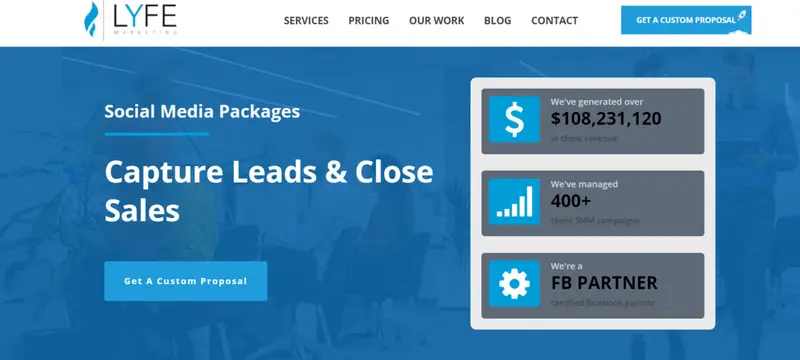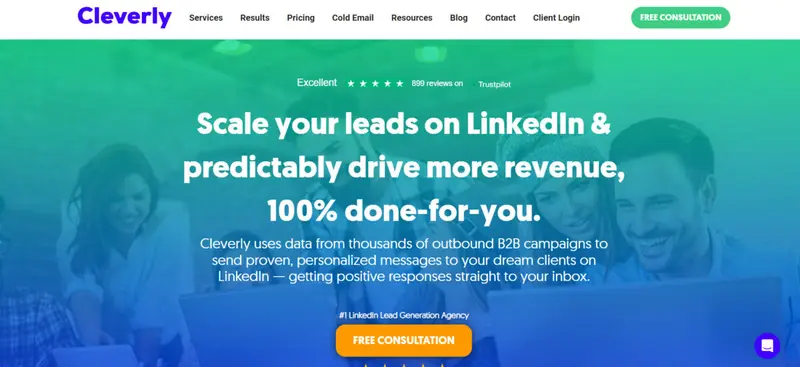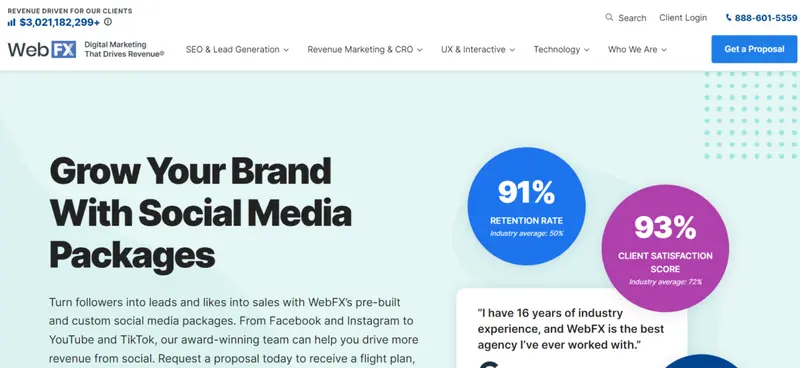You can think of a social media marketing package as one of those combo meals you get at your favorite fast-food, drive-through. It groups together all the essentials you’ll need to grow a brand via social media at a set price (and, yes, hamburgers and fries are sometimes essential food groups).
Similarly to those combo deals, clients also have the opportunity to add extras to their bundle of services. This way, businesses of all shapes and sizes can walk away satisfied.
What’s in it for social media marketing agencies? A steady stream of income, more security, and a way to show off their wide range of skills.
From deciding on which social networks to managing client expectations, here’s the process involved in creating a social media marketing package broken down into five steps. Then, to help you decide on a flat rate and see how everything comes together, also included are examples of how other agencies are structuring their services.
Step 1: Defining Your Service Portfolio
You first need to have clarity about the scope of services you can offer and types of content you can create. Allow your mind to consider services that you would like to offer down the line too. For example, if you’ve always seen yourself as a community leader, perhaps now will be a good chance to explore the idea of community management more actively?
After you’ve drawn up a list, ask yourself where your specialties lie? Examples of popular specialized services clients often need include search engine optimization (SEO), strategy consulting, and influencer partnerships.
The idea is to find the right balance between your own skills and experience and demand. Basically, you want to play towards your strengths. For example, if you have loads of experience in social media strategy, make this one of the core services in your package.
Step 2: Tailoring Your Package Tiers
You have a good idea of the types of services that you can offer, now you’ll need to find a way to combine them in a way that makes sense. To use the analogy of that combo meal again, if your fast-food joint serves pizza and hamburgers, serving a slice of pizza as a side to your hamburger won’t make much sense. Fries go with hamburgers.
In social media, there are also certain services that go together. For example, TikTok and video production go hand in hand. Offering TikTok as a platform won’t make much sense without some form of help in the video production department.
However, you don’t need to cram all your services into one package. This is where tiered packages come into the picture. You’ll typically offer three packages. A basic plan to target new clients or small businesses that are only beginning to use social media. A mid-sized plan for something in between. Then, for enterprise clients, you can offer advanced packages. This way, you’ll have a package to offer all prospective clients, irrespective of their budget or where they’re at in their journey.
Step 3: Content, Profiles, and Insights
Along with services, one of the key questions will be identifying the social media channels that you want to support. Just like with services, you don’t need to offer it all. Though, ensure that you’re very clear right from the start about which social media networks you can include.
You also have a few options. You can create a platform-specific package (you can refer to Cleverly for some guidance and inspiration) or limit it to a few channels per package. Limiting it to one platform can be a good idea if you’re a specialist in TikTok, LinkedIn, or Instagram, for example.
Aside from the number of channels, you’ll also need to clarify the frequency of content creation. However, there’s no magic formula.
Mireia Boronat, the content marketing manager at The Social Shepherd, a leading agency that walked away with the Best Large Social Media Agency in the UK award at the UK Social Media Awards 2023, explains:
She adds:
Then, you’ll also need to decide on reporting frequency and format. For example, will it be weekly reports, biweekly calls, or monthly Zoom meetings? Basically, how much time will you spend each month per client to explain the progress and results?
You’ll also need to decide how you will measure the results and share it with your clients. For example, will they have access to real-time results that they can view via a client portal or dashboard anytime they like or will they have to wait for you to send a report in PDF format?
These are all questions that you have to think about beforehand.
Step 4: Offering Versatile Add-ons
Ensure that you also include some level of customization. By including customizable services as an add-on, you’re much better equipped to meet a client’s unique requirements and expand your potential client pool. You can, for example, offer it as one-time services for those projects that clients typically don’t require on a monthly basis.
It’s also a great way to show off all of your skills. This way, you can still find a way to offer a service that you couldn’t include in one of your packages. If you’re offering add-ons, make sure that you clearly communicate that it’s available at an extra fee.
Examples of add-ons can include:
- Social media account setup
- Landing page design
- Custom graphics or product photography
- Social media moderation
- Training
- Extra social media platforms
Step 5: Guiding Clients With Parameters
One of the big benefits of offering social media packages is that you get to set expectations beforehand. Potential clients can see what they’ll get and at which price point. In other words, what’s included and excluded.
To make the most of this potential pro, ensure you specifically address the following:
- Communication expectations
- Content production details
- Number of edits
- Availability and support
For example, will communication be via email, phone, or both? Will your team be available during business hours for client calls? If so, what’s the average response time? Do they need to schedule a meeting, for instance? These are all questions that you’ll need to answer before signing up a new client.
It’s also key that clients know what to expect in terms of the approval process. If you don’t limit the number of edits you’re willing to make to social media ads, for example, the process can drag on forever.
Top Tips for Effective Marketing
1. Optimize your content for the specific platform
The content that you share on social media should be original, relevant to the brand, and optimized for the specific platform on which it will be shared.
While it's important to know who the target audience is, it’s just as important to understand the platform and its algorithms. She adds:
2. Prioritize unique content
To build a solid brand identity that’s easily recognizable, you’ll need to create unique content.
Mireia’s suggestion is that you use trends as inspiration. “You can't just copy the same trends as everyone else. Content and ideas need to be original to surprise and be memorable. This means that it's okay to use a trend as inspiration but always add your own twist to it to make it unique to the brand.”
Examples of some social media trends that digital agencies can use in 2025 for inspiration include:
- Short-form video content
- Livestream shopping
- User-generated content (UGC)
3. Use analytics
Sure, conversion rates matter, but that’s not the only way to measure success. Engagement rate is another one of the key performance indicators (KPIs) to monitor, especially for social media campaigns.
It’s not only there to show your clients how their posts are performing. It should also be used by the social media team to guide them. There are several user-friendly social media analytics tools that will highlight what worked (and what didn’t). You can then use this info to improve your social strategy and content mix.
Examples of Marketing Packages
Here’s how three of the top social media marketing agencies have structured their marketing packages:
LYFE Marketing offers a number of packages including one focused on social media advertising and another concentrating on the management side of things. Both packages include: Its social media advertising packages are structured based on the type of content and platform options. There’s a package for image ads, video ads, and a third that combines the two. The cheapest plan limits it to image ads and two platforms. As for pricing, each plan has a minimum monthly social ad spend with the cheapest plan starting at $500. There’s also an account setup fee of $300 and a monthly management cost which ranges between $750 and $1,550. Leveraging both paid ads and organic growth, they grow their clients’ social media followings. Then, to keep clients up to speed with this growth, they include monthly reports and scheduled monthly calls. The social media management packages look pretty much the same. Here, clients also have three options based on content type and frequency. The options are: All three packages include page monitoring and responding as well as sponsored posts and follower ads. Cleverly’s packages are examples of how you can create a platform-specific package. They’re one of the leading LinkedIn lead generation agencies and focus their services mainly on LinkedIn. They offer a number of packages that are tailored around: For example, the managed LinkedIn ads packages start at $999 per month for a monthly ad spend of up to $3,000. This includes: Then, to keep clients informed, it offers: However, for more in-depth reporting, you’ll need to sign up for one of the other two plans. These plans offer more frequent and granular reporting. Also, in terms of content creation frequency, the other two plans also offer more. For example, its mid-tier plan also includes new ad images after the initial ads. However, for unlimited image revisions and ad development, clients will need to sign up for its enterprise plan. WebFX offers prebuilt as well as custom plans. All plans include: While they’ll monitor your social assets on a daily basis, they’ll only report back to you on a monthly basis, irrespective of your tier. The major differences between the its three different levels are: For example, in some instances, WebFX’s most expensive tier offers three times as many pieces of content and networks. As for pricing, the ongoing management fee ranges between $3,000 and $4,800. There’s also a setup fee. Though, unlike LYFE Marketing, the setup fee is quite a sum and actually more than the monthly fee. Depending on the plan, they charge anything between $4,500 and $7,200. 1. Lyfe Marketing
2. Cleverly
3. WebFX
Frequently Asked Questions
How do you make a marketing package?
Here are seven of the essential steps involved in creating a marketing package:
- Make a list of the services that you can offer
- Decide on the different levels of tiers that you want to offer
- Identify the channels that you’ll support (e.g. which social networks)
- Clarify how many content pieces you’ll create per month
- Identify possible add-on services
- Clarify the availability of your team
- Decide on the pricing
Then, to help you market your different marketing packages, you can also create a marketing pack that consists of printed marketing material like brochures.
What should a marketing package include?
A marketing package generally includes a mixture of the following digital services:
- Strategy
- Content marketing
- Social media marketing
- Paid search and/or social
- Website editing/maintenance
- SEO
- Analytics and reporting
How many types of marketing packages are there?
There are several types of marketing packages. In addition to social media marketing packages, examples of the most common ones are:
- Email marketing packages
- eCommerce marketing packages
- Content marketing packages
- Pay-per-click (PPC) marketing packages
- SEO packages
- Digital marketing packages
What are the packaging strategies?
Packaging strategies set goals that can be used to guide decisions regarding design. It will take into account factors like efficiency, durability, material, budget, and timelines. It will help you to select the right packaging material to match the quality of your product. It should also be unique, strengthen the brand, and highlight the benefits of the product.
What is a branding package?
A branding package is a group of assets created for a business to help it communicate a uniformed brand. It’s most often used by businesses that are brand new or established ones that are planning a rebrand. It will typically include discovery to identify the brand’s target audience, unique selling proposition, and competitors. As for asset creation, it will generally include logo design, a mission statement and tagline, color palette, typography, and a brand style guide.








![A 7-step Guide to Creating a Digital Marketing Package [+ Examples Included]](https://s.influencermarketinghub.com/imaginary/resize?width=400&height=200&type=webp&url=https://influencermarketinghub.com/wp-content/uploads/2023/12/How-do-you-create-a-digital-marketing-package-1.png)
![Unpacking Marketing Packages Guide [Types & Cost]](https://s.influencermarketinghub.com/imaginary/resize?width=400&height=200&type=webp&url=https://influencermarketinghub.com/wp-content/uploads/2024/01/What-is-in-a-marketing-package.png)
